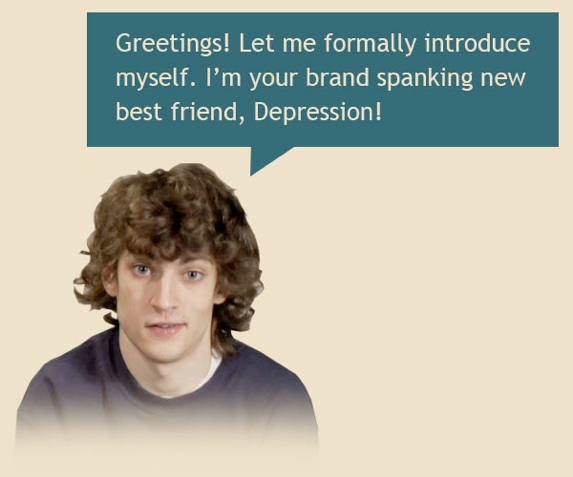Latest Public Service Radio Minute
Loss of EmploymentLoss of Employment, MP3, 1.3MB
Listen to or download all our PSAsSupport Our Work
Please donate so we can continue our work to reduce the stigma of psychiatric illness, encourage research, and support educational activities for behavioral health professionals and the public. Ways you can donate and help are on our Support and Donations page. Thank you!
More InfoLatest News Around the Web
For Middle School Kids, Witnessing School Violence May Be As Bad As Being Bullied, Study Suggests
HealthDay (9/28, Dallas) reported, “For middle school students, witnessing school violence can be as bad as being bullied,” researchers concluded in a study that “involved nearly 4,000 students in Quebec.” The study revealed that children “who had seen physical assaults or someone carrying weapons in the eighth grade had a higher risk of drug use and delinquency later on.” The findings were published online Sept. 5 in the Journal of Epidemiology and Community Health.
Related Links:
— “Just Witnessing School Violence Can Leave Psychic Scars, “Mary Elizabeth Dallas, HealthDay, September 28, 2018.
Evidence Does Not Support Commercial Rush Of DNA Tests Designed To Inform Decisions Regarding Patients’ Psychiatric Medications, Review Indicates
STAT (9/28, Robbins) reported that “several dozen companies” are now “probing patients’ DNA in search of insights to help inform decisions about what psychiatry medications patients should take,” and are even “touting applications for depression, bipolar disorder, attention deficit hyperactivity disorder, and post-traumatic stress disorder.” Now, “some top psychiatrists say the evidence doesn’t support the commercial rush.” In fact, in a review published online April 25 in the American Journal of Psychiatry, “a task force of the American Psychiatric Association’s research council concluded that such genetic testing is not ready for prime time in their field.” The members of the task force wrote, “Although some of the preliminary published data sound promising…there is insufficient evidence to support widespread use of combinatorial pharmacogenetic decision support tools at this point in time.”
Related Links:
— “In the race to use genetic tests to predict whether antidepressants will work, science might be getting left behind, “Rebecca Robbins, STAT, September 28, 2018.
Employees’ Mental Health Costs Rising Twice As Fast As Other Medical Expenses, Data Indicate
CNBC (9/27, LaVito) reports data from Aetna Behavioral Health show that the amount spent by employers on mental health “has been rising at a rapid clip – with annual costs increasing twice as fast as all other medical expenses in recent years.” Darcy Gruttadaro, director of the American Psychiatric Association Foundation’s Center for Workplace Mental Health, said, “We all have a point at which stress can creep into negatively impacting our overall health and wellness,” and “employers are increasingly recognizing … the importance of taking care of health, well-being and mental health, and also the role stress, isolation, loneliness and some of these other factors can play in overall mental health and well-being.”
Related Links:
— “Anxiety is expensive: Employee mental health costs rise twice as fast as all other medical expenses, “Angelica LaVito, CNBC, September 27, 2018.
VA Releases National Suicide Data Report
According to the Wall Street Journal (9/26, Kesling, Subscription Publication), the most recent Department of Veterans Affairs National Suicide Data Report reveals suicides have increased in veterans aged 18 to 34. Click here (pdf) to read the report.
Related Links:
— “More Young Veterans Committing Suicide, VA Data Show, ” Ben Kesling, The Wall Street Journal, September 26, 2018.
US Suicide Rates Rising, CDC’s Schuchat Says
According to The Hill (9/26, Bonn), on Sept. 26, Dr. Anne Schuchat, “the principal deputy director of the Centers for Disease Control (CDC), warned…that suicide is on the rise in the U.S. among almost every age group.” Speaking with “Rising” Hill. TV co-hosts Krystal Ball and Buck Sexton, Dr. Schuchat said, “Suicide – in all ages except for young children and the elderly – is one of the few conditions that’s getting worse instead of better around the country.” Currently, “suicide is a leading cause of death in the” United States, “and suicide rates have spiked more than 30 percent in half of states across the country since 1999, according to the CDC.”
Related Links:
— “Suicides in the US are up, says CDC official, “Tess Bonn, The Hill, September 26, 2018.
Foundation News
Nothing Found
It seems we can’t find what you’re looking for. Perhaps searching can help.

